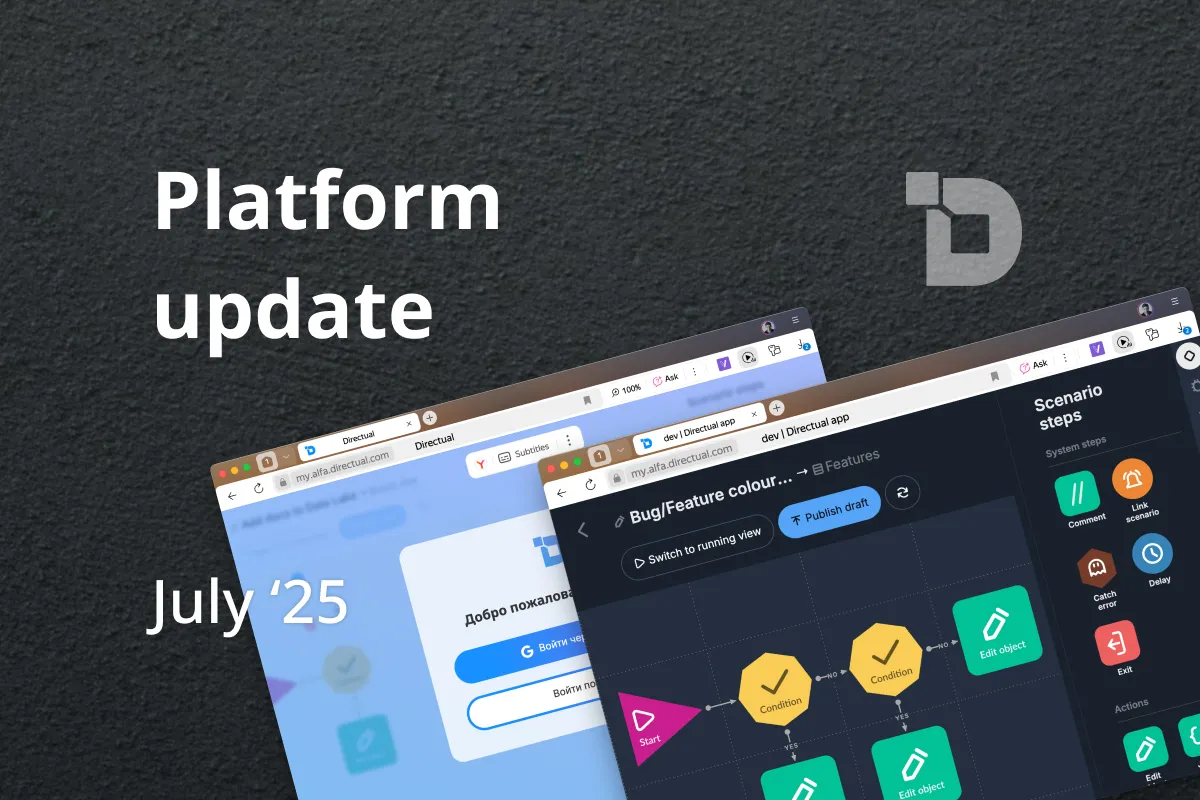Brief view to low-code
Wikipedia low-code definition:
Low-code platform is software that provides an environment programmers use to create application software through graphical user interfaces and configuration instead of traditional computer programming.
Generally speaking, low-code uses a LEGO-like approach to creating IT-solutions. From a business perspective, low-code enables development to become faster and cheaper. It’s achieved by means of two factors:
- Analysts and non-IT staff low-code training takes just a few weeks, whereas traditional programming training can take years.
- Managing larger blocks allows for highly flexible and therefore easily modifiable software and reduces the number of bugs.
From an IT point of view, proper platform helps to avoid a mishmash of different IT-solutions, increase IT-department effectiveness and move on to the stable process of microservices based digitalisation.
According to Gartner, by 2023, more than 25% of the IT-solutions, websites, mobile apps and conversational apps will be built and/or run through low-code platforms (in Gartner terms: “High productivity development platform or multi-experience development platform”).
Let’s dive into details: the origin of low-code technology, variety of low-code platforms on the market, their differences, implementation of low-code tools by large enterprises.
The origins of low-code technology
Pace of change on the markets is constantly accelerating leading to increasing business competition. Companies and enterprises are looking for ways of becoming more efficient by creating and implementing new digital products. These can be both: end-user products (e.g. e-catalogs and self-service applications) and products for internal business processes automation and optimisation (e.g. logistics or HR processes optimisation).
There have always been two approaches to digital product creation: development from scratch and packaged solution implementation. For the most part, packaged solutions come with a built-in business process, that company needs to adjust to or develop further, which can take years. Development from scratch, on the other hand, takes business requirements into account, but can also take up a considerable period of time. This is also compounded by a lack of qualified programmers on the market.
It soon became apparent that the market needed an alternative — a solution as flexible as regular development, but much faster and easier. Visual programming concept was developed in the late 20th century, but its implementation was hindered due to a lack of proper ready-made technologies. In recent years such technologies became available and made processing large data flows possible in real time. Consequently, new and effective solutions for low-code development followed and quickly became an alternative to heavy and inflexible packaged solutions and demanding process of development from scratch.
Types of low-code platforms
As low-code platforms are gaining increasing popularity, more and more systems position themselves as low-code platforms, presenting in reality BPM, CRM or ERP solutions, or being simply an instrument for creating flowcharts. Let’s try to clear up what fully-featured low-code solution really is.
There are several important features of any low-code development platform:
- Visual development tool for creating scenarios, which can be processed in real time;
- Almost no need for new modules programming;
- Instruments for integrating data from external IT systems;
- Application lifecycle management mechanisms as independent microservices.
However, two low-code platforms containing the above-mentioned features will never be completely identical. Some feature better visual forms and tables designer, others — powerful set of ready-made integrations and advanced BI-module. There are very good but niche solutions, e.g. for industrial IoT or CRM. But for the long-term IT architecture development one should opt for highly scalable and universal platforms to avoid dealing with various IT systems.
Low-code pros and cons
The reasons behind the rising popularity of low-code development platforms:
- Speed. Low-code platform based development is significantly faster compared to traditional programming, as it takes place at a higher level. The majority of routine operations, which used to be taken care of by programmers and DevOps engineers, are now fully integrated. Infrastructure configuration workflow is no longer needed.
- Flexibility. Experience makes it plain that no solution can be thought through from the ground up. The system needs to be flexible and therefore easily modifiable. Low-code provides this high level of flexibility. Instead of rewriting piles of code blocks or setting up inflexible packaged solutions, analysts can simply configure scenarios in already known intuitive graphical interfaces.
- Microservice architecture. Nowadays IT-solutions have to adapt to all kinds of businesses and enterprises. Modern low-code platforms make it possible to develop every solution as an independent microservice with its own project team. But at the same time, all microservices are integrated into one databus, bringing together all the pieces of IT architecture and creating an integrated system.
- Integration with existing IT architecture. All, or almost all, company processes are nowadays automated by means of traditional inflexible legacy systems (e.g. SAP, Oracle or 1C). The major benefit of low-code based application development is its capability to integrate with legacy systems and utilize data from existing IT systems in newly created digital products.
Just like any other new technology, low-code was treated with caution at first. Here is a list of popular low-code myths and some arguments to debunk them:
- Myth 1. Low-code development is only for simple applications. This is obviously not true, for experience has shown otherwise. Any complex IT system can be divided into several microservices, each of which is responsible for a specific task. Every microservice can be created on a low-code platform and combined with the rest. It’s also possible to integrate specific modules (e.g. machine learning model) into a single process. For instance, that’s how a project developed on Directual made it possible to optimally redistribute assets within a company group operating in 16 countries.
- Myth 2. Low-code is not suitable for high-load applications. This is fair only for the old visual programming systems from 2000s. Modern platforms (such as Directual) are initially designed for linear scaling of all infrastructure nodes (e.g. event queue, data warehouse or processing). It allows to configure the infrastructure to sustain high and irregular load on the final application.
- Myth 3. Low code platforms increase data security risks. In fact, it's exactly the other way round. Since the platforms are created specifically for enterprise application development, security is not only carefully thought through, but also tested many times over. In the IT system developed from scratch programmers cannot avoid leaving weak spots and vulnerabilities, which can only be exposed during its operation. For instance, Directual provides a special tool for access rules configuration and API management. This tool is called Security Layer and it guarantees reliable protection from unauthorised data access.
- Myth 4. Lack of low-code developers. This argument can be easily confuted by short learning curve for citizen developers, as professional programming skills are not required. For example, average training period of Directual platform analyst is 14 days.
Essentially, low-code platform based digital products development is not very different from traditional development. Although the use of visual tools allows to make this process much more effective and safe resources of highly-skilled professionals for programming and infrastructure management, as low-code provides an opportunity to do it faster with fewer qualified professionals involved.
Low-code development on Directual
Directual is an industrial low-code platform. Directual based systems are complex but flexible and, therefore, can easily be adapted to new requirements. Moreover, the platform provides enterprise level of stability and security crucial for business-critical IT systems.
Small cross-functional microservice teams
Every application is developed by a separate team, bringing together analysts, business representatives, designers and programmers (if necessary). Teams are operating independently, in sprints, testing and collecting feedback after every iteration. This allows for effective and simultaneous implementation of several large and complex projects with continuous user feedback analysis.
Prioritising UI/UX
Directual doesn’t impose interface templates, as modern IT systems must be well-thought-out by UX specialist and designed taking all user requirements into account. With that in mind, Directual completely covers logic and API layer functionality, providing opportunity for unique and user-friendly Web interface or mobile app creation.
Rapid product iteration
Rapid iteration is the fastest route to the right solution. Directual allows to create digital products within 1-3 weeks using rapid iterations, collecting user feedback and modifying the product. As a result, it becomes possible to use fully-featured Agile-approach even for enterprise software development.
Simple platform enhancement
Directual acts as an application orchestrator by managing all data flows through scenarios, leaving open the possibility to add any specific module and integrate it into scenario logic, e.g. pretrained machine learning model or pattern recognition system. The platform basically “glues” different modules together to fix any specific application data processing issue.
Highly flexible scenarios
Directual scenarios are essentially based on data processing. Due to this abstract approach it’s possible to implement any logic: from sensor reading processing to entertainment mobile app backend development.
Put it in a nutshell, Directual is an industrial platform with wide range of possibilities. It allows for not only digital product MVP development, but also for its further enhancement without any ultimate limitations.
Where to start?
In order to understand the advantages of low-code technology in relation to your company or enterprise you just have to try it out. We are always happy to discuss possibilities of low-code for your specific tasks, that need high-quality and user-friendly digital products in a short period of time. Do not hesitate to contact us via hello@directual.com
















































